GTX 980 Ti and Oculus Rift
Hello GT! A month ago, I talked about the hardware and capabilities of the GTX 980Ti, one of the fastest consumer graphics cards of this generation. Today I want to share with you the most interesting of what I could do with this thing - the work of the GTX 980Ti and the Oculus Rift DK2 VR system.
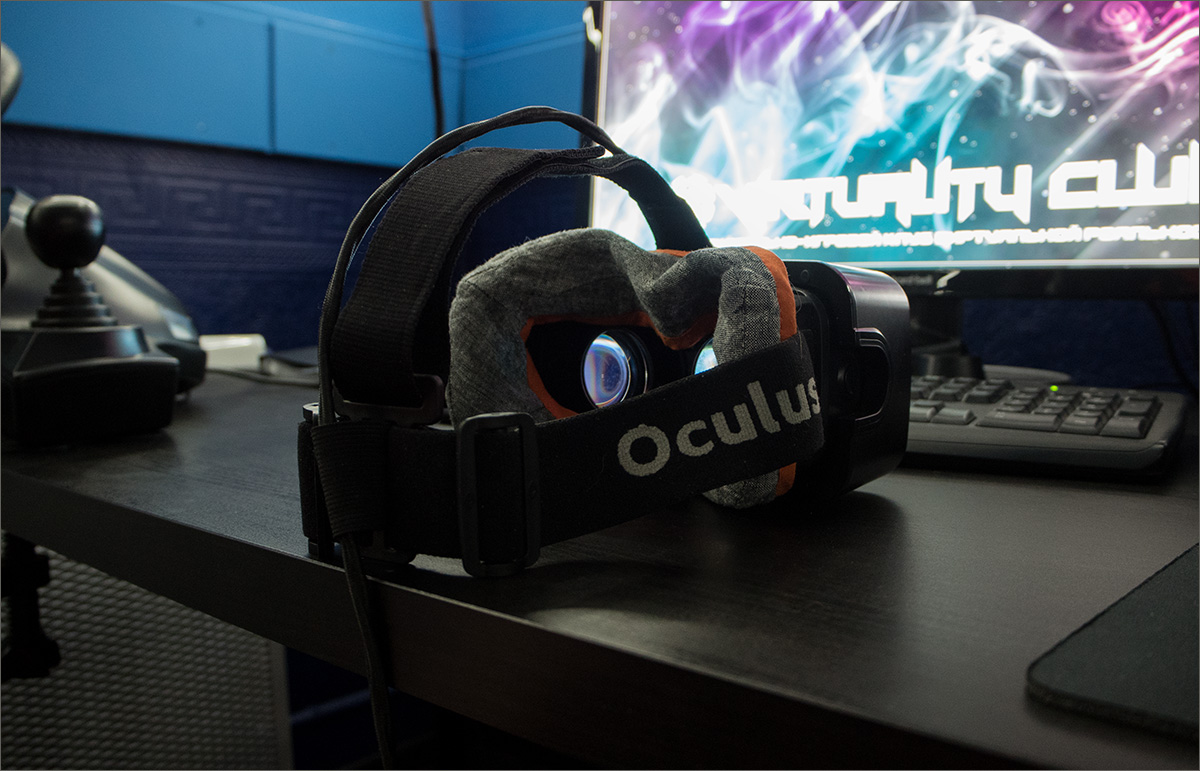
About Oculus has been told more than once, including on the GT. For example, here is an excellent translation by TheSpyMonkey , which describes the alleged system requirements of the final version of the VR helmet, and the main problems of the current hardware.
If we briefly consider the actual problems for Oculus (and, I think, the other systems that various companies managed to spawn) problems, then they all come down to three large blocks:
For modern toys and their engines, work with VR systems was not meant. In some places, developers post factum screw compatibility with Oculus Rift drivers, in some places there are amateur mods and improvements. In general, there is no question of optimization and sharpening for VR in current games, we must wait for toys sharpened for VR systems. This is the first problem.
The second - well, if you need to build a frame for one monitor. But for Oculus and its analogs, two frames must be taken, and not identical, but also with different parallax / offset, so that the effect of immersion is maximum.
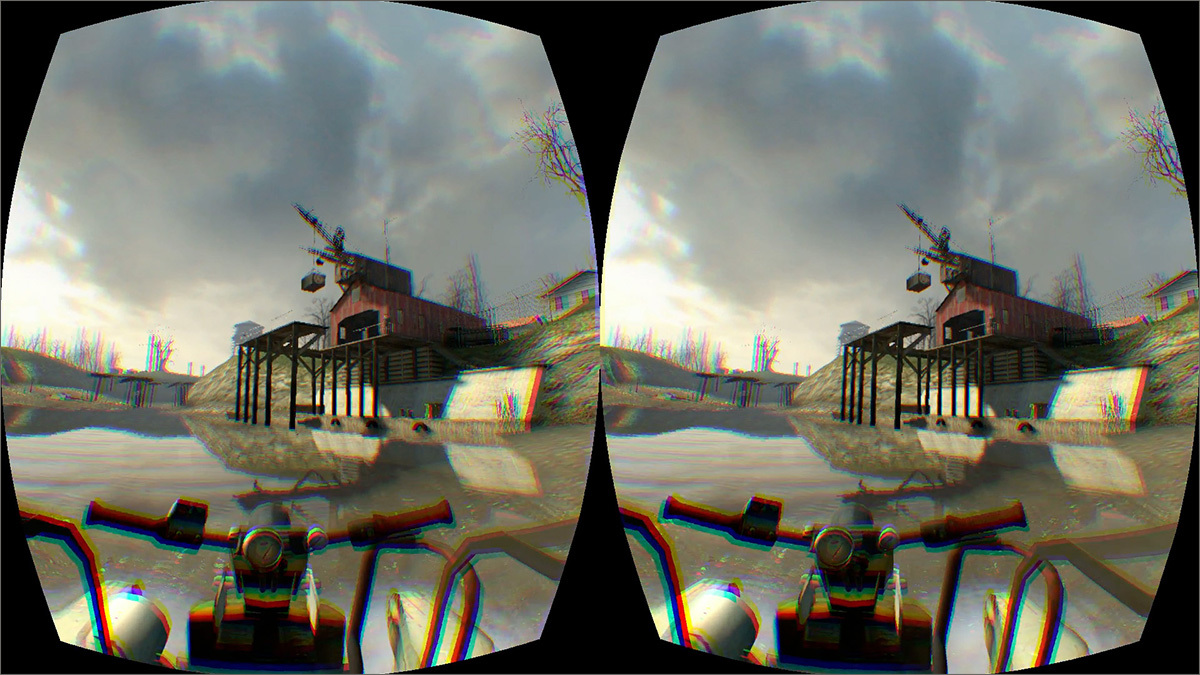
If the geometry, some shaders, and other delights of building a three-dimensional picture allow you to use the same data twice in memory, then all sorts of Z-buffers and various special effects (as well as GUI overlay) require quite serious iron and twice do all the work of calculating the frame. The video card must have good performance and margin for ROPs (those elements that turn a 3D picture into a “flat” frame, which is sent to the display) in order to draw two different frames.
Perhaps future graphics systems will be designed with the widespread use of VR systems as game monitors, and the drivers / hardware will be optimized for two frames from one with a shift, but now these problems only increase the hardware requirements: even if the release the Oculus Rift version will not have 2160x2160 or 1440x1440 displays for each eye, the video card must be taken with a margin.
Now Oculus VR itself calls the R9 290 and GTX 970 video cards “recommended” for DK2 (Developer Kit 2, the current version of the VR helmet), while the “eye” resolution is only 960 × 1080 pixels, though there are some nuances here we'll talk a little later.
The third problem is laptop owners. The performance of modern mobile chips, of course, is somewhat inferior to desktop ones, but remains at a fairly serious level. Their capabilities to drive "on average settings" with a virtual reality helmet may well be enough, but the problem is that not all laptops are properly organized HDMI-output. Energy-saving systems (such as Nvidia Optimus, which allows you to run a voracious discrete video chip only when the video from Intel built into the processor can no longer provide normal performance) can become a prediction stone, because all the output of the picture in them is still run through the built-in video adapter and is sent from it to the HDMI port, and the “minimum requirements” of RIFT include 2 USB ports version 3.0 and HDMI 1.3c with direct output (or better, 1.
As you can see, the problem is optimization, optimization, and optimization again. That is, until there is a ready market for 3D helmets, there will be no normal support from software and hardware developers. And they want the content to be ready and slowly finish their product. We can only wait or buy overpowered iron.
To test Oculus (the device is expensive enough to buy it “to play with”, it’s also a Developer Kit, not a complete commercial product with all the consequences), I turned to friends from the first virtual reality entertainment and gaming club : I brought my 980Ti , after which we tested it on various settings for half a day.
A few words about the equipment of the club itself: now there are 4 PCs installed, three of which work with the GTX 970 (we already wrote about it in three parts: 1 , 2 , 3 ), in addition, one of them is connected to a special system with VR-assisted an armchair.

There are a lot of different toys installed, but the number of AAA titles, alas, is more modest. Of the 100% working (and working as they should) - Half-Life 2, Team Fortress 2, Live for Speed, Assetto Corsa, WarThunder, GTA 5. These toys also work well: Minecraft, Battlefield 4, Crysis 3, Borderlands 2 and Darkness 2.
Some games have to feed a third-party driver, and the gameplay on them may look strange. However, this does not save us from the oddities of the gameplay with the “native” support of Oculus: for example, Half-Life 2 has separate control of the head and the “trunk”. No, it is "like in real life", but it requires a habit. And the camera is strangely fixed in it, as a result of which it is sometimes difficult to navigate (especially from unaccustomed to), and to play productively, remembering all the shotcats and other tricks - and this is a very severe challenge.

Some games with patches come with more adequate support for the VR helmet, some, on the contrary, completely lose touch with reality, support falls off, drivers do not interact with the helmet / game (hi, Project CARS) in general, while everything is damp, but really cool experience from VR can be obtained on what will be advised in the club itself.
In most games, the GTX 970 handles high settings without any problems. But high - this does not mean maximum. We put the GTX 980Ti, check the driver update, set the virtual 4k2k resolution and "everything to the maximum." Works. Somewhere 40 FPS, somewhere 55-60, but insanely powerful 980Ti copes with this. Even GTA 5 with crazy settings, a virtual resolution of 2560x1440 and a third-party driver for Oculus Rift quietly runs at 40 frames per second.
Well, now about the sad. There is definitely no difference in picture between the GTX970 and GTX 980Ti, and now I’ll tell you why.
Inside Dev. Kit'a second version is AMOLED screen from Samsung Galaxy Note with a resolution of 1920 × 1080 pixels. It has a very high response speed, and it has a number of features that are necessary for high-quality work in VR glasses. Even Sony with their favorite IGZO matrices in Project Morpheus will have an AMOLED screen. Fly in the ointment - PenTile.
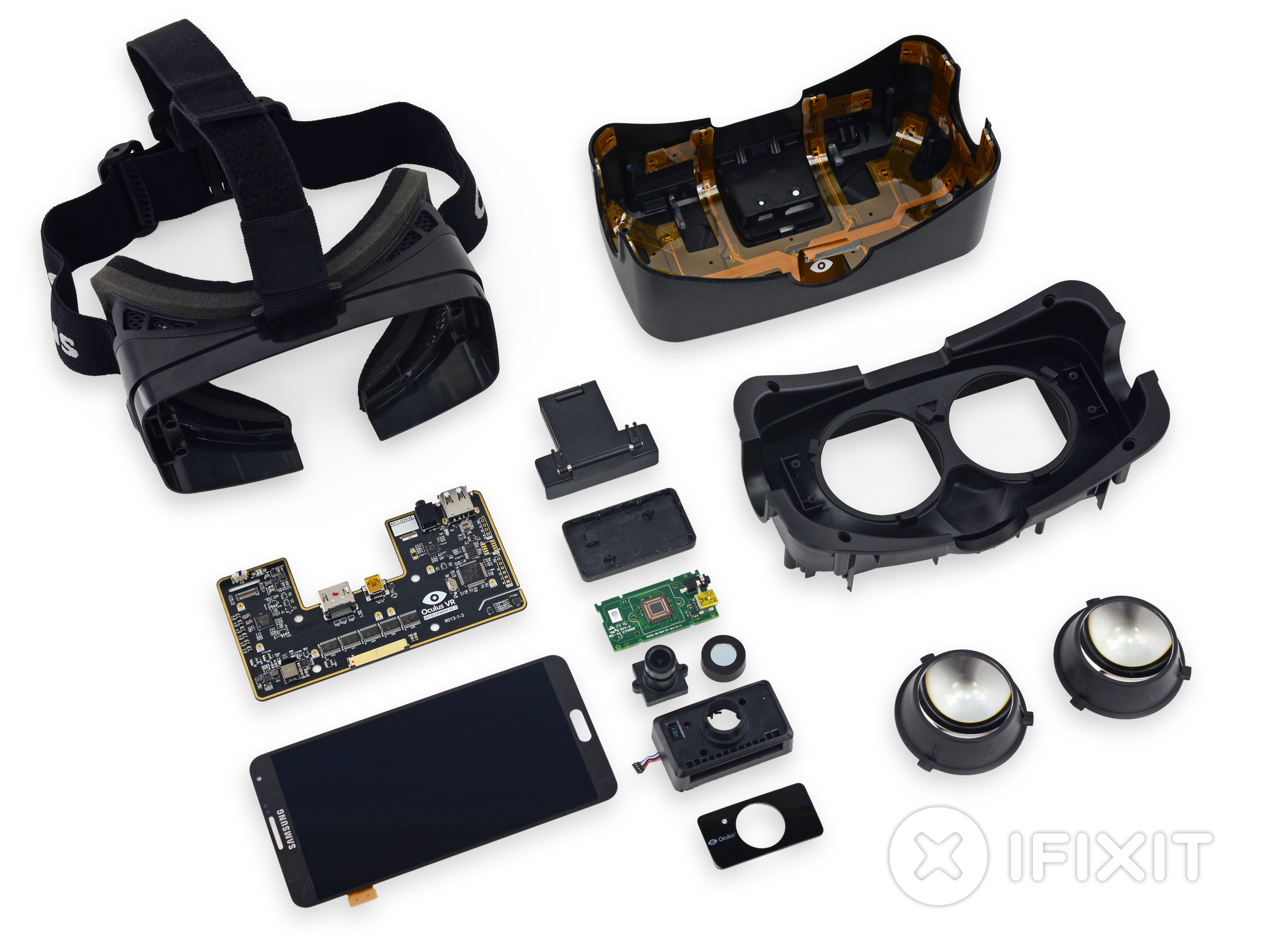
Inside, there really is a screen from Note, even technological slots for buttons and sensors remain.
The ill-fated “chess” arrangement of subpixels does not affect working with a phablet or smartphone, the resolution is high, the “comb” is almost invisible. Here the display is right in front of your eyes, and even taking into account special lenses ... let's just say that the detail of the picture is very so-so. So the difference between the “maximum”, “super maximum” and “absolutely indecent maximum” settings you will not see. And the GTX 970 will pull on ordinary “high” ones. However, they promised to fix this low-resolution thing in the release version, then the GTX 980Ti will come in handy.
Версия для простых смертных, а не разработчиков и энтузиастов выйдет в следующем году. Обещают 1440x1440 или 2160x2160 для каждого глаза, что само по себе повысит нагрузку на GPU, так что владельцам GTX 970 останется только снижать настройки до «высоких» или «средних», особенно те, которые напрямую затрагивают пиксельную производительность, ROP’ы (которых у 970 маловато) и работу с памятью (расход которой для двух «мониторов» только увеличится). А вот пользователи GTX 980 и особенно GTX 980Ti смогут чувствовать себя комфортно — у «простой» версии относительно GTX 970 как раз нет этих бутылочных горлышек, а GTX 980 Ti и вовсе палка-нагибалка, ей всё ни по чём.
The video card, of course, is an overkill for current needs, but it is good as a backlog for 3-4 years in advance. Those who already managed to buy it a month ago are probably happy, because the dollar exchange rate did not spare the price of this monster, I can only sympathize with the rest, now 980Ti costs about 48 thousand rubles for a simple version and about 52-54 rubles for custom ones , with improved cooling system and factory overclocking.
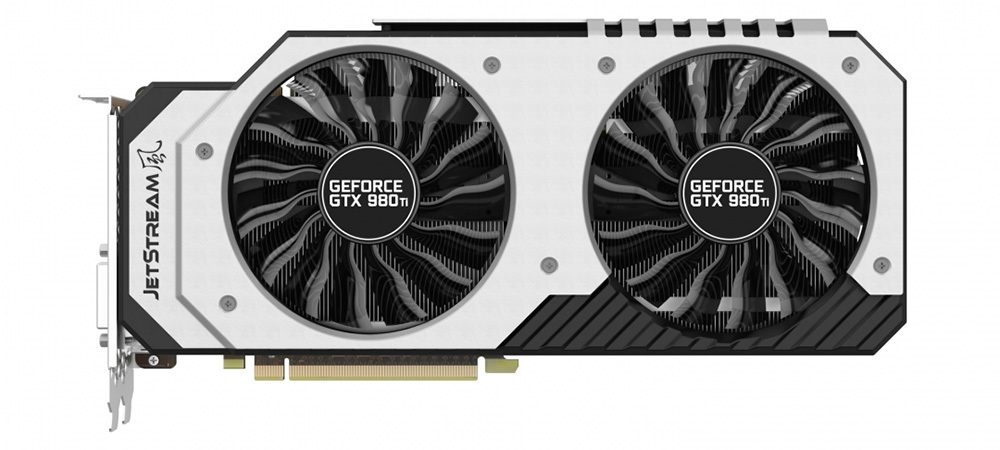
Nevertheless, Radeon's cost not much less, FuryX (about which there is also material) in tests hangs at the GTX 980Ti level (somewhere faster, somewhere slower), which can be attributed to raw drivers and various test equipment configs for different reviewers and users, in addition, it has only 4 GB of memory compared to 6 for 980Ti.

The R9 390X is more likely a competitor for the regular 980 and just a good card for GPGPU, with a huge memory reserve (8 GB) and uncompromising FP64 performance for the money.
The most interesting thing of all that is there, of course - an interactive chair (motion simulator in virtual reality).
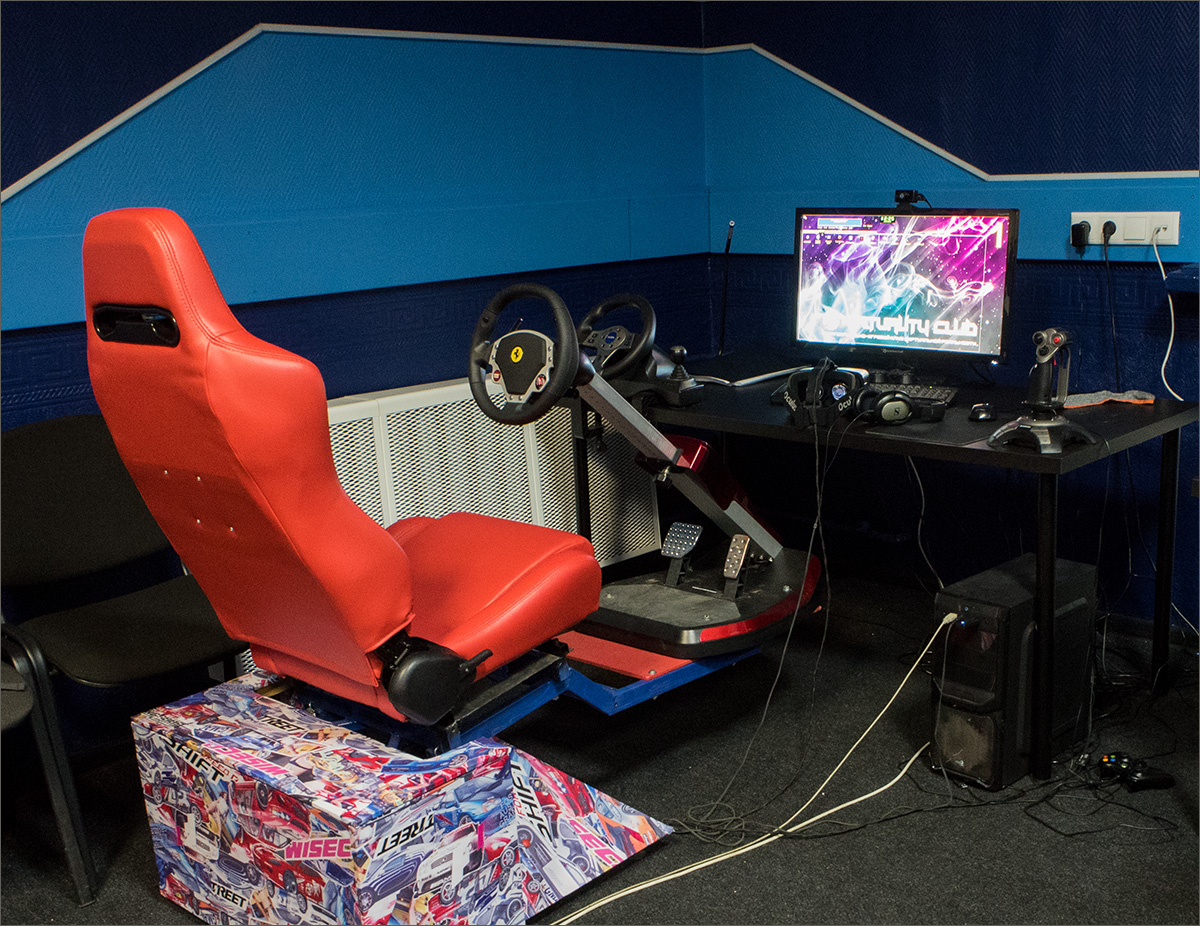
Together with Oculus, it gives an amazing sense of presence. After him, playing "just racing" or indulging in a "roller coaster" sitting on the couch is not at all right. In addition, with this chair, disorientation and seasickness syndrome greatly decreases / disappears.

It’s clear that acceleration and deceleration (that is, overload) cannot be conveyed, but the sensation of a car or “freezing” at the turning points of a roller coaster, a dead loop or a “barrel” gives more than decent ones, and the rest completes your brain.
Anyone can try Oculus Rift in this miracle chair in Moscow, the guys have all the phone numbers, turnout addresses and passwords on the site. Well, if you really want your own Oculus Rift, you can also get it there. And from me, thank them very much for the day spent, benchmarks and fuss with the GTX 980Ti, it was worth it.
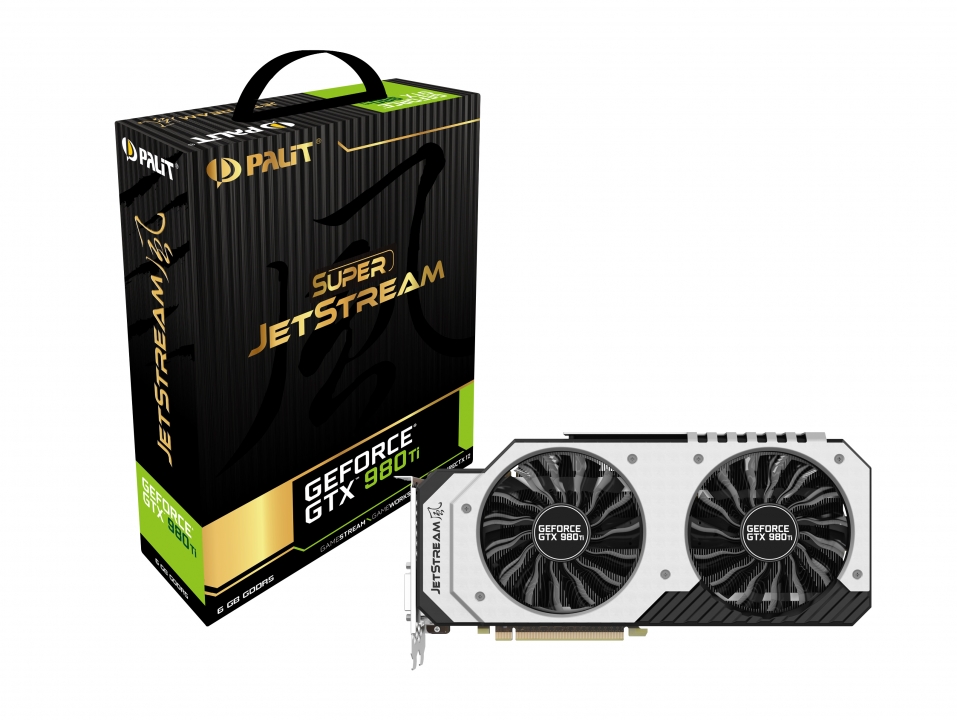

About Oculus has been told more than once, including on the GT. For example, here is an excellent translation by TheSpyMonkey , which describes the alleged system requirements of the final version of the VR helmet, and the main problems of the current hardware.
Chicken and Egg Problem
If we briefly consider the actual problems for Oculus (and, I think, the other systems that various companies managed to spawn) problems, then they all come down to three large blocks:
For modern toys and their engines, work with VR systems was not meant. In some places, developers post factum screw compatibility with Oculus Rift drivers, in some places there are amateur mods and improvements. In general, there is no question of optimization and sharpening for VR in current games, we must wait for toys sharpened for VR systems. This is the first problem.
The second - well, if you need to build a frame for one monitor. But for Oculus and its analogs, two frames must be taken, and not identical, but also with different parallax / offset, so that the effect of immersion is maximum.

If the geometry, some shaders, and other delights of building a three-dimensional picture allow you to use the same data twice in memory, then all sorts of Z-buffers and various special effects (as well as GUI overlay) require quite serious iron and twice do all the work of calculating the frame. The video card must have good performance and margin for ROPs (those elements that turn a 3D picture into a “flat” frame, which is sent to the display) in order to draw two different frames.
Perhaps future graphics systems will be designed with the widespread use of VR systems as game monitors, and the drivers / hardware will be optimized for two frames from one with a shift, but now these problems only increase the hardware requirements: even if the release the Oculus Rift version will not have 2160x2160 or 1440x1440 displays for each eye, the video card must be taken with a margin.
Now Oculus VR itself calls the R9 290 and GTX 970 video cards “recommended” for DK2 (Developer Kit 2, the current version of the VR helmet), while the “eye” resolution is only 960 × 1080 pixels, though there are some nuances here we'll talk a little later.
The third problem is laptop owners. The performance of modern mobile chips, of course, is somewhat inferior to desktop ones, but remains at a fairly serious level. Their capabilities to drive "on average settings" with a virtual reality helmet may well be enough, but the problem is that not all laptops are properly organized HDMI-output. Energy-saving systems (such as Nvidia Optimus, which allows you to run a voracious discrete video chip only when the video from Intel built into the processor can no longer provide normal performance) can become a prediction stone, because all the output of the picture in them is still run through the built-in video adapter and is sent from it to the HDMI port, and the “minimum requirements” of RIFT include 2 USB ports version 3.0 and HDMI 1.3c with direct output (or better, 1.
As you can see, the problem is optimization, optimization, and optimization again. That is, until there is a ready market for 3D helmets, there will be no normal support from software and hardware developers. And they want the content to be ready and slowly finish their product. We can only wait or buy overpowered iron.
About the performance of the Oculus Rift system and NVidia cards
To test Oculus (the device is expensive enough to buy it “to play with”, it’s also a Developer Kit, not a complete commercial product with all the consequences), I turned to friends from the first virtual reality entertainment and gaming club : I brought my 980Ti , after which we tested it on various settings for half a day.
A few words about the equipment of the club itself: now there are 4 PCs installed, three of which work with the GTX 970 (we already wrote about it in three parts: 1 , 2 , 3 ), in addition, one of them is connected to a special system with VR-assisted an armchair.

There are a lot of different toys installed, but the number of AAA titles, alas, is more modest. Of the 100% working (and working as they should) - Half-Life 2, Team Fortress 2, Live for Speed, Assetto Corsa, WarThunder, GTA 5. These toys also work well: Minecraft, Battlefield 4, Crysis 3, Borderlands 2 and Darkness 2.
Some games have to feed a third-party driver, and the gameplay on them may look strange. However, this does not save us from the oddities of the gameplay with the “native” support of Oculus: for example, Half-Life 2 has separate control of the head and the “trunk”. No, it is "like in real life", but it requires a habit. And the camera is strangely fixed in it, as a result of which it is sometimes difficult to navigate (especially from unaccustomed to), and to play productively, remembering all the shotcats and other tricks - and this is a very severe challenge.

Some games with patches come with more adequate support for the VR helmet, some, on the contrary, completely lose touch with reality, support falls off, drivers do not interact with the helmet / game (hi, Project CARS) in general, while everything is damp, but really cool experience from VR can be obtained on what will be advised in the club itself.
In most games, the GTX 970 handles high settings without any problems. But high - this does not mean maximum. We put the GTX 980Ti, check the driver update, set the virtual 4k2k resolution and "everything to the maximum." Works. Somewhere 40 FPS, somewhere 55-60, but insanely powerful 980Ti copes with this. Even GTA 5 with crazy settings, a virtual resolution of 2560x1440 and a third-party driver for Oculus Rift quietly runs at 40 frames per second.
Well, now about the sad. There is definitely no difference in picture between the GTX970 and GTX 980Ti, and now I’ll tell you why.
Oculus Rift DK2
Inside Dev. Kit'a second version is AMOLED screen from Samsung Galaxy Note with a resolution of 1920 × 1080 pixels. It has a very high response speed, and it has a number of features that are necessary for high-quality work in VR glasses. Even Sony with their favorite IGZO matrices in Project Morpheus will have an AMOLED screen. Fly in the ointment - PenTile.

Inside, there really is a screen from Note, even technological slots for buttons and sensors remain.
The ill-fated “chess” arrangement of subpixels does not affect working with a phablet or smartphone, the resolution is high, the “comb” is almost invisible. Here the display is right in front of your eyes, and even taking into account special lenses ... let's just say that the detail of the picture is very so-so. So the difference between the “maximum”, “super maximum” and “absolutely indecent maximum” settings you will not see. And the GTX 970 will pull on ordinary “high” ones. However, they promised to fix this low-resolution thing in the release version, then the GTX 980Ti will come in handy.
Oculus for users
Версия для простых смертных, а не разработчиков и энтузиастов выйдет в следующем году. Обещают 1440x1440 или 2160x2160 для каждого глаза, что само по себе повысит нагрузку на GPU, так что владельцам GTX 970 останется только снижать настройки до «высоких» или «средних», особенно те, которые напрямую затрагивают пиксельную производительность, ROP’ы (которых у 970 маловато) и работу с памятью (расход которой для двух «мониторов» только увеличится). А вот пользователи GTX 980 и особенно GTX 980Ti смогут чувствовать себя комфортно — у «простой» версии относительно GTX 970 как раз нет этих бутылочных горлышек, а GTX 980 Ti и вовсе палка-нагибалка, ей всё ни по чём.
GTX 980Ti
The video card, of course, is an overkill for current needs, but it is good as a backlog for 3-4 years in advance. Those who already managed to buy it a month ago are probably happy, because the dollar exchange rate did not spare the price of this monster, I can only sympathize with the rest, now 980Ti costs about 48 thousand rubles for a simple version and about 52-54 rubles for custom ones , with improved cooling system and factory overclocking.

Nevertheless, Radeon's cost not much less, FuryX (about which there is also material) in tests hangs at the GTX 980Ti level (somewhere faster, somewhere slower), which can be attributed to raw drivers and various test equipment configs for different reviewers and users, in addition, it has only 4 GB of memory compared to 6 for 980Ti.

The R9 390X is more likely a competitor for the regular 980 and just a good card for GPGPU, with a huge memory reserve (8 GB) and uncompromising FP64 performance for the money.
A few more words about the VR club
The most interesting thing of all that is there, of course - an interactive chair (motion simulator in virtual reality).

Together with Oculus, it gives an amazing sense of presence. After him, playing "just racing" or indulging in a "roller coaster" sitting on the couch is not at all right. In addition, with this chair, disorientation and seasickness syndrome greatly decreases / disappears.

It’s clear that acceleration and deceleration (that is, overload) cannot be conveyed, but the sensation of a car or “freezing” at the turning points of a roller coaster, a dead loop or a “barrel” gives more than decent ones, and the rest completes your brain.
Anyone can try Oculus Rift in this miracle chair in Moscow, the guys have all the phone numbers, turnout addresses and passwords on the site. Well, if you really want your own Oculus Rift, you can also get it there. And from me, thank them very much for the day spent, benchmarks and fuss with the GTX 980Ti, it was worth it.

